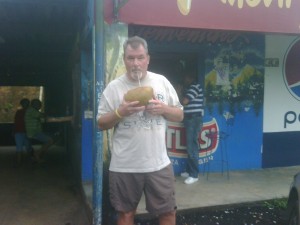Remembering Coach
I met Richard Humphries in May of 2008. He had come to Costa Rica for stem cell treatment for his secondary progressive MS. He had come with Sgt. Preston Walker of the Ft. Worth Police department. My role at ICM was management and overseeing the laboratory, so I didn’t meet many patients. Richard and Preston stopped me as I was heading out the front door to a meeting. Richard said, “If you guys are thinking of trying anything new, we’re game.”
The doctors and I had been talking for several months about using the patient’s own fat as a source for mesenchymal stem cells. They had been using only mesenchymal stem cells grown from umbilical cords. But the process was quite expensive which limited the number of cells that could be given. If they could take about a pound of belly fat, they could potentially get over 100 million cells from that alone. There was plenty of information coming from the veterinary world about treating autoimmune diseases with the stem cells isolated from fat. So Doctor Solano explained the concept to them, and they decided to go for it.
Richard and Preston therefore became the first two people with multiple sclerosis to be treated with stem cells from their own fat. Theirs along with the third patient’s cases were written up in a scientific journal article that was published the following year—after extensive examinations including new MRIs etc. The results were very positive and there were no side effects other than the bruising from the liposuction that was required to get the fat. Richard and Preston are famous for coming into the office 2 days after the liposuction, raising their shirts and saying, “So, this is what you call a ‘little’ bruising?”
I became fast friends with both Richard and Preston.
Richard had a good response but wound up having to come back because he was having a relapse in October 2009. He responded well again. Richard and I made a pact (well, it was more of suggestion of Richard’s—those of you who knew him well will know what I mean—he had a Ph.D. in the power of suggestion)—if he was still better the next summer, we would make a trip to Panama and accomplish the following: Golf (for him), play blackjack (for me), and swim in both the Pacific and Atlantic oceans in one day (for both of us).
We made the trip. On a Friday night we drove from Panama City to a beach area on the Pacific coast that had both a casino and a golf course named the Decameron. We found a little beach restaurant/bar called Woody’s (named for it’s Canadian owner) not far away and decided to have their dinner special—steak and lobster (for only fifteen bucks). There were only a few people there when we ordered our dinner. The place was somewhat of a local watering hole for Expats and they filtered in over the next few hours. Richard started up a conversation with one group, and before we left, we were on a first name basis with virtually everyone in the place. It took us 30 minutes to leave because everyone wanted to hang out with Richard. That sums up his personality to a T. If I had gone to that place by myself or with anyone else, I would probably have not even met a single person—instead I met everyone. Richard had this effect on people everywhere I went with him. He went with me to buy a pickup when I moved to Texas and, yet again, everyone in the dealership knew us by name before we left.
We went to the casino after the restaurant that night and proceeded to win 900 bucks—enough to pay for the Panama part of the trip. In the morning we got up to play golf. Richard shot a 2 under on a course he had never seen much less played on. What a golfer. Had he not had MS I’m sure he would have played on the PGA Senior Tour. In a phone text to me just about month ago he said he had just hit a 462-yard drive. He admitted it was downwind. I would never bet against his golf abilities or his coaching abilities. He taught two of my kids how to smack some pretty good golf balls from scratch in almost no time.
He was always coaching, even when he wasn’t. We played together in a charity golf tournament the last three years. This spring would’ve marked out fourth year. Each year he would stack our team with his students. All of them revered him. They called him “Coach”, as did I. His nickname for me was “Breaux” since I had lived in Southern Louisiana when working in the oil field, and was familiar with the nickname and appreciated his crawfish Étouffée. People in the lab said that we had a “breauxmance.”
Back to Panama. After another winning night of blackjack at the casino, we woke up early on Sunday. After breakfast we went swimming in the Pacific Ocean. We showered up and headed to the Atlantic. It should only take about 1.5 hours but we got lost and it took more like 4. The whole time we were cutting up and it didn’t seem that long at all. We finally arrived at an old port on the Atlantic side. We realized we didn’t have any towels. So we went to a little store and all they had were tea towels. Well, you know Richard was around 6’ 5” and I probably still outweighed him, so we bought 50 tea towels (they were 10 for a dollar). And we went swimming! We laughed all the way back to Panama city about how ridiculous we must’ve looked to the locals in the port as we dried ourselves off with the tea towels.
Fast forward to this week. We received a text from Laura on Tuesday morning that Richard was in critical condition at the hospital. We went as soon as we could that day. When we asked for his room, the nurse at the station said, “that man is a celebrity—everyone is coming to see him—through the glass doors on the right.”
Richard is a celebrity. Not because he was in movies or a rock and roll star. He is a celebrity because he cared. You know he cared because he noticed. He had a power of observation that I have never seen in another person. He could tell when things were right and when they were not and would always be there to encourage and nudge you in the right direction.
There is a Zulu greeting that fit Richard: “Sowubona.” It literally means, “I see you.” Not, hello, howdy, wassup?, or how’s it going? No matter what his greeting was, Richard was seeing you. His seeing would always be followed by gentle, practical nudging that would lead you to see yourself a little bit differently—which made you feel better about yourself and your capabilities. I saw it time and again, whether it was with me, his students, his family, or the hundreds of patients who sought out his advice and insights on stem cells.
His practicality was one of his most endearing traits and was part and parcel to his nudging. He wrote a series of articles for his golf students that he shared with me and other members of our staff called “Between Your Ears” that were chocked full of practical advice and insights. Shirley and I were scheduled to fly to Tokyo on Wednesday and considered canceling the trip. I heard Coach’s voice in my head, “Breaux, why are you going to go and do that for? You know you can’t do anything about it.”
So we went. And awoke in Tokyo to the news that my brother had passed.
Coach, rest in peace. I miss your nudges. Sowubona, I will always see you.
Breaux
aka Neil Riordan


